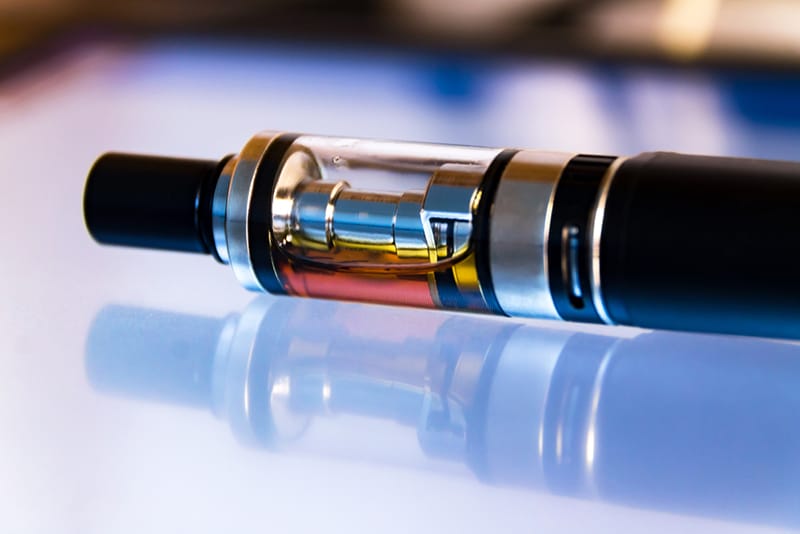E-liquid leaking out a vaporizer’s tank is an issue that frustrates and vexes new and experienced vapers alike. Leaking is arguably the most common nuisance that vapers are likely to encounter and try to solve. Fortunately, diagnosing the cause of leaking and resolving it is typically straightforward and easier than it is often thought to be. Following this guide will help to solve the problem before setting foot in a shop is even needed.
Easy Vape Leaking Fixes to Check First
Leaking can often be fixed without an in-depth guide. Below are some of the fixes to check before taking the tank apart.
Picking the Right E-Liquid
On a sub-ohm tank, it is critical to make sure that proper e-liquid is being used. Salt nicotine should almost always be avoided in sub-ohm tanks both because they contain far too much nicotine and because they are too thin. Thin e-liquids will be more likely to run through the cotton of sub-ohm atomizers which is a major culprit of leaking. Optimal e-liquids for sub-ohm tanks will have viscosities ranging from 30/70 to 10/90 PG/VG.
Picking the Right Wattage
If the vaporizer in question has variable wattage features, it is critical to make sure that the selected wattage is within the recommended range of the coil/atomizer being utilized. If the wattage is too high the cotton can burn out and allow e-liquid to pass through. If the wattage is too low, not enough e-liquid will pass through the cotton and thus the cotton will not be adequately saturated. Unsaturated cotton will eventually burn and cause leaking.
Checking the Age of the Coil/Atomizer
Coils are replaceable for the sole reason that cotton has a finite lifespan. Cotton will always deteriorate over time when submerged in e-liquid and subject to heat. Most modern replacement coils have an average lifespan of two to three weeks. If the coil in the leaking tank in question has been used for longer than that span of time, replacing it may stop the leakage.
Is the Tank or the Coil the Culprit?
Determining whether or not the tank itself or the coil/atomizer it houses is at fault is the first step in solving the problem of leaking. In rare instances, both can be malfunctioning, however, it is almost always the case that one or the other rather than both is causing the headache. Answering this dilemma is done with a simple process of elimination, starting with the tank itself.
.
Option A: The Tank
In most cases, it is easy to determine if the tank itself is the weak link by giving it a visual inspection. Here are the likely reasons why the tank itself is responsible for leaking.
Glass
Cracks in the glass are usually easy to identify with a quick look over. Cracked glass can both allow e-liquid to leak from the points of damage and/or depressurize the tank, resulting in the e-liquid spilling out the bottom of the tank. If the glass is indeed cracked the only solution is to replace it as overtime those cracks will grow and may well shatter. Fortunately, virtually every tank and starter kit come packaged with at least one glass replacement. If no replacements are at hand, The Vapor Lab will likely have some in stock.
Seals
If the glass is not cracked upon inspection, the next items to check are the rubber seals or O-rings that fix the glass in place. These seals tend to be durable, however, if e-liquid is leaking from where these rubber rings meet the glass, they may well be the culprit. Damaged seals will show signs of fraying/tearing which break the air-lock of the tank, depressurize the device, and can allow e-liquid to escape through the damaged rubber. Like broken glass, the only way to fix damaged seals is to replace them.
Tank Cap/Filling Port
One thing that can cause a tank to potentially leak is if the tank cap may be loose or not closed completely. Most tanks have a removable cap, a swiveling cap or a sliding cap that is used to refill the tank when your e-liquid level is low. If this cap or filling port is not completely closed or partially closed then it will create a vacuum and the e-liquid can leak from the airflow ports at the base of the tank.
Option B: The Coil
If a tank’s glass and seals both seem to be in working order after inspection, then it is time to check out the coil. Coils are more often the cause of the leak than the tank itself and are fortunately easy to fix or replace. Below is a list of the ways in which coils can cause leaking.
Cross Threading
Coils are integral in their role of sealing the e-liquid contained inside the tank from the outside. One of the ways in which this seal can be broken is when the coil is improperly loaded or cross threaded into the base of the tank. A cross-threaded coil is often most easily identified by it sticking out at an angle rather than perpendicular to the base of a tank. If the coil can be removed and then reinserted properly, then the leaking should be fixed (unless there is another issue in tandem with the cross-threading). If the coil cannot be properly reinserted, then the tank itself may have to be replaced entirely as its base is irreparably damaged.
Burnt Cotton
Now comes the most likely culprit for tank leakage; burnt coils. Coils/atomizers all contain cotton which serves the critical role of only introducing e-liquid into the heating element when the user inhales. Without this cotton barrier, any e-liquid that would be introduced to the tank would fall out it’s base in short order.
The same rule applies to bunt cotton as this damage deteriorates the barrier and will cause increasingly more leakage as the coil experiences continued usage. It is important to note that a coil with burnt cotton may not taste burnt at first. Flavorful e-liquids can mask or even completely hide the foul taste of burnt cotton. Burnt coils must be replaced in order to solve the leakage.
The Tank and the Coil Seem Fine, Now What?
If the above options and methods have been exhausted and the tank continues to leak, it becomes time to look into peripheral causes of leakage.
Exposure
E-liquid is much like water in that its physical state can change with exposure to extreme heat and cold. Common example of this occurring is when a vaporizer is left in a hot car. Excessive heat causes the e-liquid to thin to a point in which the cotton barrier of the coil is not sufficient in sealing it within the confines of the tank.
Cold environments have an opposite effect on e-liquid as it can cause the fluid to thicken. When e-liquid thickens too much it can brcome unable to enter the cotton barrier, even with inhalation taking place. Cotton that is not sufficiently saturated with e-liquid will eventually burn, which as discussed earlier, will also lead to leakage. Unless the cotton has sustained damage, removing the vaporizer from these extreme conditions should fix any leaking that has occurred.
Air Pressure
Although seldom the primary cause of leaky tanks, changes in altitude can be responsible for leaking. It is always recommended to completely drain the tank before flying as the drastic change in altitude will likely cause the e-liquid to rapidly thin and leak. Traveling up and down mountainous areas can also cause this phenomenon to occur.
Inactivity
Tanks can also experience leaking when they are filled and then left alone for great lengths of time. A full tank will start to leak after a week or two if it remains inactive. This is caused by the oversaturation of the cotton barrier of the coil. Inactive cotton will slowly absorb more and more e-liquid until it becomes too full and will start to drain.
Still Having Leaking Issues? Call Us!
The Vapor Lab is open seven days a week and we are always happy to help with any leaking issues our customers are experiencing. If none of the above fixes seem to solve the leakage, please feel free to call, email, or visit the shop for further assistance!

